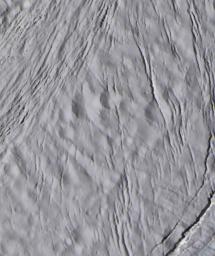The finest details on the surface of Saturn's moon Enceladus are revealed in this 30-meter (100-foot) per-pixel, enhanced-color image taken during Cassini's closest-ever encounter with Enceladus on March 9, 2005.
The surface of Enceladus is almost uniformly white and even though the natural color of this scene has been exaggerated in intensity, no obvious departure from the uniform hue is apparent. The image was also processed to enhance contrast while avoid saturation of the brightest parts of the scene. Hence, the surface does not have the brightness of fresh snow, as it would appear to the human eye.
The Sun is illuminating the surface from the left of the image and at a low enough angle that the rugged ridge crests near upper left (which range in height from 50 to 100 meters or 164 to 328 feet) cast dramatic shadows, as at the top center of the image. The origin of the very small dark spots in the ridged terrain is uncertain. They could be shadows cast by small, building-sized outcrops (approximately 60-meter or 200-feett high) just at the limits of resolution.
Intriguingly, the craters in this scene are quite subdued, indicating that they have been degraded by some process. The craters clearly predate most of the fractures.
Additionally, multiple sets of fractures running in different directions can be seen. One set above the lower right has a gentle appearance similar to that of the craters. In contrast, the fractures running along the left are fresher. By studying differences in the morphology and patterns of the fractures, scientists will be able to learn about Enceladus' crust and how it, and geologic processes acting within it, have changed over time.
Images obtained using red, green and blue spectral filters were combined to create this view. The image was taken with the Cassini spacecraft narrow-angle camera at a distance of approximately 5,200 kilometers (3,200 miles) from Enceladus and at a Sun-Enceladus-spacecraft, or phase, angle of 39 degrees. The scene is centered on a region at -3 degrees latitude and 218 degrees longitude.
The Cassini-Huygens mission is a cooperative project of NASA, the European Space Agency and the Italian Space Agency. The Jet Propulsion Laboratory, a division of the California Institute of Technology in Pasadena, manages the mission for NASA's Science Mission Directorate, Washington, D.C. The Cassini orbiter and its two onboard cameras were designed, developed and assembled at JPL. The imaging team is based at the Space Science Institute, Boulder, Colo.
For more information about the Cassini-Huygens mission, visit http://saturn.jpl.nasa.gov and the Cassini imaging team home page, http://ciclops.org.

 Planetary Data System
Planetary Data System












